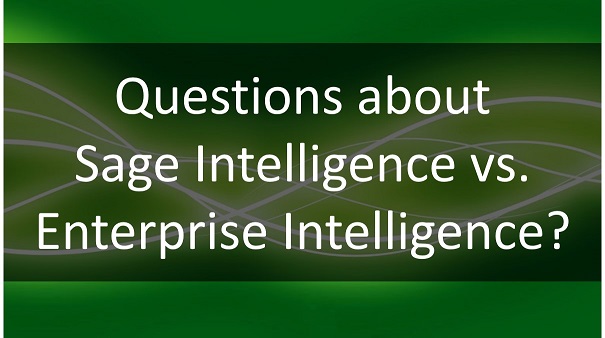I recently sat down with Scott Watts, our Sage Business Intelligence and reporting guru to address five common questions about Sage Intelligence and Sage Enterprise Intelligence. Scott is our Business Intelligence, expert.
Q1. If a customer is evaluating Sage Software Sage Intelligence (SI) and Sage Enterprise Intelligence (SEI), what are some of the requirements you look for to make a recommendation?
Scott: The most critical requirement is to understand what the reporting needs of the customer are, what types of users will be utilizing the reporting tools and if the output will need to be distributed to others.
Sage Intelligence is a great tool for Financial Reporting and is only Excel based; whereas Sage Enterprise Intelligence is exceptional with financial data plus operational and production data and offers Excel, web and mobile interfaces.
When it comes to MS Excel integration, Sage Intelligence provides limited pivot table report templates for common queries like customer sales, vendor purchases, inventory status and financial summary views. SI can connect to additional data sources other than the customer’s Sage ERP with the optional Connector license. Refreshing data is only available to the user’s initial criteria selection when generating the report. If additional time frames or other parameters change or new transactions were posted, the report will need to be generated again.
The Sage Enterprise Intelligence interaction with the MS Excel add-in license is much more flexible, allowing the user to create Excel-based reports and pivot tables using any and all of the delivered standard templates that are pre-configured and with a simple ‘refresh’ for real-time data pulls. SEI has more robust templates (processes) out-of-the-box. A common example is a customer that wants to link Production and a legacy system or might want to include financial data along with statistical information on customers or products.
Both SI and SEI offer distribution capabilities but SEI has simplified administration of distribution setup and scheduling.
Only SEI offers security and global restriction capabilities allowing an SEI view (worksheet report, chart, dashboard or Excel workbook) to be created once but based on the user accessing via the client tools or receiving the distributed output, limits what that user can see. Examples would be only showing a sales rep details of their respective customer whereas a manager could see the same view of the entire customer base.
Finally, only Sage Enterprise Intelligence offers a browser-based client and a Mobile client with a streamlined user interface and cheaper license to view reports and dashboards from any device, anywhere.
See Also: Sage Intelligence vs. Enterprise Intelligence: What's the Difference?
Q2. What is the Sage Enterprise Intelligence Excel Plug-In and why would a customer need it?
Scott: The Sage Enterprise Intelligence Excel Add-In license extends the capabilities beyond reporting and dashboard views. The Sage Enterprise Intelligence Excel Add-In makes the data accessible from within MS Excel for flexible ad-hoc reporting. For example, a customer can extract parameterized data from any source into a single worksheet, format columns in MS Excel, filter criteria of specific data values, create pivot tables, then refresh the data at any time. A formula wizard allows the end user to summarize any data in Sage Enterprise Intelligence using Sum, Count, Average, Minimum, Maximum or List operations. All SEI security is built into your Excel worksheets.
Q3. Are there limitations for SI Report Viewer licenses?
Scott: Yes. Sage Intelligence Report Viewers cannot design new report templates. SI Report Viewers are restricted to selecting from pre-selected filter criteria and running reports only.
Sage Intelligence Report Manager includes Report Designer capabilities that allow users to create and run reports in real-time, customize and save reporting templates, as well as the ability to distribute reports. –Depending on your Excel knowledge, users can choose between two options to create and design reports in Microsoft Excel.
See Also: Sage Intelligence Features "Cheat Sheet" (Quick Reference)
Q4. How can a customer prepare for an implementation of either reporting tool?
Scott: First, customers should clearly define reporting data sources as well as the desired format and layout of the reporting requirements. If a customer wishes to connect to other data sources, especially external data sources, general IT knowledge of the database location and/or administrator accessibility is a must. If that’s not possible, we would need to coordinate the external connectivity with another individual.
For Sage Enterprise Intelligence, since it’s web-based, the software needs to be configured on an IIS server and its database components must be installed on MS SQL Server. A Business Intelligence license is required for admin function and SEI web client configurations. As you can see, setting up Sage Enterprise Intelligence requires a user with technical skillsets or access to an IT resource.
Q5. Best Practices, tips & tricks for customers to apply during the implementation and post go-live?
Scott: To help new customers prepare for report design, training and usability we recommend to:
- Pick one easy report and one complex report for 2 different training scenarios. Or, pick one financial and one operational report for different conditions.
- Prioritize the most critical reports for the first-month end after go-live
- Document and/or record training sessions for future recollection and reminders
- Master Microsoft Excel functions and shortcuts.
The ideal trainee should have MS SQL-type skills, knowledge of the data schemas, and MS Excel power tools like pivot tables, grouping, formula management, etc.
Like This Article? You Might Also Like:
Big Data vs. Big Pile of Data
Detailed Review of Sage Intelligence vs. Enterprise Intelligence
Understanding Your Business Through Data Analysis
Webinar Replay:
Exploring Sage Business Intelligence Options




